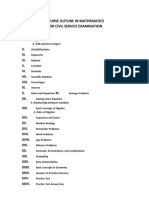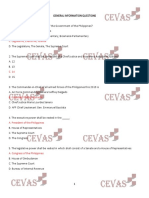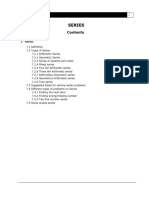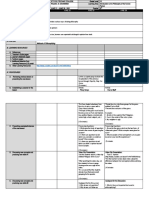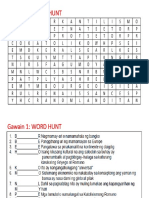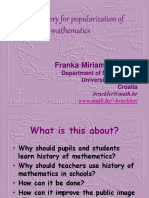CSC Number Series
Uploaded by
Raquel disomimbaCSC Number Series
Uploaded by
Raquel disomimbaQuestions on number series are prevalent in most of the management aptitude exams.
These questions
are based on numerical sequences that follow a logical rule/ pattern based on elementary arithmetic
concepts. A particular series is given from which the pattern must be analyzed. You are then asked to
predict the next number in the sequence following the same rule. Generally, there are three types of
questions asked from the number series:
A numerical series is given in which a number is wrongly placed. You are asked to identify that particular
wrong number.
A numerical series is given in which a specific number is missing. You are required to find out that
missing number.
A complete numerical series is followed by an incomplete numerical series. You need to solve that
incomplete numerical series in the same pattern in which the complete numerical series is given.
Different types of Number Series:
The most common patterns followed by number series are:
Series consisting of Perfect Squares:
A series based on Perfect squares is most of the times based on the perfect
squares of the numbers in a specific order & generally one of the numbers is
missing in this type of series.
Example:324, 361, 400, 441,?
Sol: 324 = 182 , 361 = 192, 400 = 202, 441 = 212, 484 = 222
Perfect Cube Series:
It is based on the cubes of numbers in a particular order and one of the
numbers is missing in the series.
Example:512, 729, 1000,?
Sol:83, 93, 103, 113
Geometric Series:
It is based on either descending or ascending order of numbers and each
successive number is obtained by dividing or multiplying the previous
number by a specific number.
Example:4, 36, 324, 2916?
Sol:4 x 9 = 36, 36 x 9 = 324, 324 x 9 = 2916, 2916 x 9 = 26244.
Arithmetic Series:
It consists of a series in which the next term is obtained by adding/subtracting a constant number to its
previous term. Example: 4, 9, 14, 19, 24, 29, 34 in which the number to be added to get the new number
is 5. Now, we get an arithmetic sequence 2,3,4,5.
Two-stage Type Series:
In a two step Arithmetic series, the differences of consecutive numbers themselves form an arithmetic
series.
Example: 1, 3, 6, 10, 15.....
Sol:3 - 1 = 2, 6 - 3 = 3, 10 - 6 = 4, 15 - 10 = 5....
Now, we get an arithmetic sequence 2, 3, 4, 5
Mixed Series:
This particular type of series may have more than one pattern arranged in a single series or it may have
been created according to any of the unorthodox rules.
Example:10, 22, 46, 94, 190,?
Sol:
10 x 2 = 20 +2 = 22,
22 x 2 = 44 + 2 = 46,
46 x 2 = 92 + 2 = 94,
94 x 2 = 188 + 2 = 190,
190 x 2 = 380 + 2 = 382.
So the missing number is 382.
Arithmetico –Geometric Series :
As the name suggests, Arithmetico –Geometric series is formed by a peculiar combination of Arithmetic
and Geometric series. An important property of Arithmetico- Geometric series is that the differences of
consecutive terms are in Geometric Sequence.
Example:1, 4, 8, 11, 22, 25, ?
Sol :Series Type +3 , X2 ( i.e Arithmetic and Geometric Mixing)
1 + 3 = 4, 4 X 2 = 8, 8 + 3 = 11, 11 X 2 = 22, 22 + 3 = 25, 25 X 2 = 50
Geometrico - Arithmetic Series is the reverse of Arithmetico - Geometric Series. The differences of
suggestive terms are in Arithmetic Series.
Example: 1, 2, 6, 36, 44, 440, ?
Sol :Series Type - X 2, + 4, X 6, +8 , X 10
1 X 2 = 2, 2 + 4 = 6, 6 X 6 = 36, 36+ 8 = 44, 44 X 10 = 440, 440 + 12 = 452
Twin/Alternate Series :
As the name of the series specifies, this type of series may consist of two series combined into a single
series. The alternating terms of this series may form an independent series in itself.
Example: 3, 4, 8, 10, 13, 16 ? ?
Sol: As we can see, there are two series formed
Series 1 : 3, 8, 13 with a common difference of 5
Series 2 : 4, 10, 16 with a common difference of 6
So, next two terms of the series should be 18 & 22 respectively
PRACTICE:
1. 3 2 2 5 5 5 7 8 8 9 11 11 ?
1. 12 2. 11 3. 9 4. 14 5. 16
2. 7 9 8 6 10 9 5 11 10 ? 12
1. 4 2. 11 3. 56 4. 5 5. 29
3. 1 3 2 6 3 11 4 18 5 ?
1. 272. 253. 234. 295. 20
Answer & Explanation
13 17 23 29 31 37 ??
1. 222. 413. 194. 235. 27
Answer & Explanation
17 16 14 12 11 8 8 ?
1. 42. 73. 34. 25. None of the above
You might also like
- Numerical Ability (Basic Operations and Word Problems)78% (9)Numerical Ability (Basic Operations and Word Problems)12 pages
- Civil Service Examination - Math (Repaired)100% (2)Civil Service Examination - Math (Repaired)81 pages
- Free CSE Reviewers Managed by Leonalyn Mutia100% (6)Free CSE Reviewers Managed by Leonalyn Mutia14 pages
- CSC Data Interpretation and Analysis Reviewer50% (2)CSC Data Interpretation and Analysis Reviewer3 pages
- Answers To Philippine Civil Service Reviewer Problem Solving Items 1 To 2094% (48)Answers To Philippine Civil Service Reviewer Problem Solving Items 1 To 205 pages
- Civil Service Exam - Common Civil Service Exam Question and Answers100% (2)Civil Service Exam - Common Civil Service Exam Question and Answers28 pages
- Day 9 Lesson 17 Post Test For Clerical Answer Key0% (1)Day 9 Lesson 17 Post Test For Clerical Answer Key19 pages
- Part 1 Test On Correct Grammar in EnglishNo ratings yetPart 1 Test On Correct Grammar in English10 pages
- Grammar and Correct Usage Quiz 5 - PH Civil Service Exam Reviewer78% (9)Grammar and Correct Usage Quiz 5 - PH Civil Service Exam Reviewer5 pages
- 6.1 Homework-Areas Between Curves (Homework) : 11:59 PM PDT0% (1)6.1 Homework-Areas Between Curves (Homework) : 11:59 PM PDT20 pages
- Civil Service Exam Reviewer For Analogy and LogicNo ratings yetCivil Service Exam Reviewer For Analogy and Logic8 pages
- Review 7 - Numerical Reasoning and Problem SolvingNo ratings yetReview 7 - Numerical Reasoning and Problem Solving9 pages
- Civil Service Reviewer On Philippine Constitution63% (8)Civil Service Reviewer On Philippine Constitution24 pages
- Tips To Pass The Numerical Reasoning Test in Civil Service Exam100% (1)Tips To Pass The Numerical Reasoning Test in Civil Service Exam8 pages
- Civil Service Exam Clerical Operations Questions100% (5)Civil Service Exam Clerical Operations Questions5 pages
- Answers To Items 21 To 40 of The Word Problems For The Part II of The Civil Service Professional Examination Reviewer88% (25)Answers To Items 21 To 40 of The Word Problems For The Part II of The Civil Service Professional Examination Reviewer6 pages
- Civil Service Exam Reviewer For Professional and Sub Professional LevelsNo ratings yetCivil Service Exam Reviewer For Professional and Sub Professional Levels64 pages
- CSE Professional Level (Civil Service Mock Exam) PDF YesNo ratings yetCSE Professional Level (Civil Service Mock Exam) PDF Yes64 pages
- 1 Philippines-Civil-Service-Professional-Reviewer (1) (By Y.lyle@hotmail - Com)100% (1)1 Philippines-Civil-Service-Professional-Reviewer (1) (By Y.lyle@hotmail - Com)24 pages
- CSC Reviewer - English Gen. Info Abstract PDF63% (8)CSC Reviewer - English Gen. Info Abstract PDF40 pages
- Civil Service Exam Reviewer Clerical OperationsNo ratings yetCivil Service Exam Reviewer Clerical Operations9 pages
- How To Solve Number Series Problems - Number Series and PatternNo ratings yetHow To Solve Number Series Problems - Number Series and Pattern6 pages
- 1) Number Series Shortcut Tricks & TipsNo ratings yet1) Number Series Shortcut Tricks & Tips24 pages
- Intro To Philo (June 21 - June 28, 2021)No ratings yetIntro To Philo (June 21 - June 28, 2021)5 pages
- Introduction To:: By: Raquel B. DisomimbaNo ratings yetIntroduction To:: By: Raquel B. Disomimba17 pages
- I. Objectives: June 30 July 2 July 5 July 7No ratings yetI. Objectives: June 30 July 2 July 5 July 73 pages
- Multiplying Integers (B) : Find Each ProductNo ratings yetMultiplying Integers (B) : Find Each Product2 pages
- Hi, Bloom! Do You Know What Is Percentile Rank? Hello, Lily! Yes I Know But First We Have To Review What Is Percentile. Okay. So, Let's StartNo ratings yetHi, Bloom! Do You Know What Is Percentile Rank? Hello, Lily! Yes I Know But First We Have To Review What Is Percentile. Okay. So, Let's Start3 pages
- Hi, Cookies! Glad To See You Lily. I've Been To Meliza and She Said That I'll Pay You A Visit. So Let's Try How Much Have You Learned From Meliza?No ratings yetHi, Cookies! Glad To See You Lily. I've Been To Meliza and She Said That I'll Pay You A Visit. So Let's Try How Much Have You Learned From Meliza?4 pages
- Using History For Popularization of Mathematics: Franka Miriam BrücklerNo ratings yetUsing History For Popularization of Mathematics: Franka Miriam Brückler36 pages
- Bargmann, On A Hilbert Space of Analytic Functions and An Associated Integral TransformNo ratings yetBargmann, On A Hilbert Space of Analytic Functions and An Associated Integral Transform101 pages
- MULTIPLE CHOICE QUESTIONS in ENGINEERING MATHEMATICS by Diego Inocencio T. GillesaniaNo ratings yetMULTIPLE CHOICE QUESTIONS in ENGINEERING MATHEMATICS by Diego Inocencio T. Gillesania74 pages
- 2022 Cayley Contest: The Centre For Education in Mathematics and Computing Cemc - Uwaterloo.caNo ratings yet2022 Cayley Contest: The Centre For Education in Mathematics and Computing Cemc - Uwaterloo.ca282 pages
- Level 4 G8 TEST FOR FUNDAMENTAL ACADEMIC SKILLS Pre TestNo ratings yetLevel 4 G8 TEST FOR FUNDAMENTAL ACADEMIC SKILLS Pre Test3 pages
- An Introduction To PDE-constrained Optimization: Wolfgang Bangerth Department of Mathematics Texas A&M UniversityNo ratings yetAn Introduction To PDE-constrained Optimization: Wolfgang Bangerth Department of Mathematics Texas A&M University32 pages
- KKKQ1223 Engineering Mathematics (Linear Algebra) : Best Approximation Least Squares Least Squares Fitting To DataNo ratings yetKKKQ1223 Engineering Mathematics (Linear Algebra) : Best Approximation Least Squares Least Squares Fitting To Data22 pages
- For More Study Material & Test Papers: Manoj Chauhan Sir (Iit-Delhi) Ex. Sr. Faculty (Bansal Classes)No ratings yetFor More Study Material & Test Papers: Manoj Chauhan Sir (Iit-Delhi) Ex. Sr. Faculty (Bansal Classes)4 pages
- Quadratics - Past Paper Questions SolvedNo ratings yetQuadratics - Past Paper Questions Solved23 pages
- Root Locus Diagram - GATE Study Material in PDF100% (1)Root Locus Diagram - GATE Study Material in PDF7 pages
- Limits Practice - Pre-Calculus: Semester Two ReviewNo ratings yetLimits Practice - Pre-Calculus: Semester Two Review3 pages
- Cover Page: Additional Mathematics SA2 Overall Revision NotesNo ratings yetCover Page: Additional Mathematics SA2 Overall Revision Notes5 pages
- DE Applications With Well Known ExamplesNo ratings yetDE Applications With Well Known Examples20 pages

